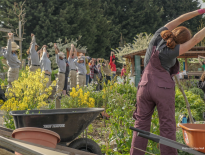What’s New With the Living Building Challenge?
Living Building Challenge 3.1 is the latest release of the LBC Standard. This version is a tweak to the 3.0 iteration, which had major updates and was released in 2014.
The Living Building Challenge (LBC) is based on idealized but realistic goals. As a result, LBC projects are among the most efficient, highest-performing and healthiest buildings in the world. The LBC Standard is the framework teams use to guide them towards LBC certification during the design, construction and operations phases of their projects. There are three possible certification paths: Living Certification, Petal Certification, and Net Zero Energy Building Certification. The requirements of the Standard are broken into seven performance areas, referred to as ‘Petals’, each of which is further subdivided into one to five Imperatives that contain specific requirements within that Petal.
The requirements of each Imperative push teams towards the ideal, and they have evolved based on collaboration with the LBC community. In addition, there are exceptions to, and multiple compliance options within, those requirements to respond to the realities of the market and the diversity of high aspiration projects engaging with the program.
The LBC has been evolving since it’s original release in 2006. Each release of the LBC includes influence from the people, projects and policy that make the creation of healthy buildings possible.
The 3.1 Standard includes clarifications and adjustments based on feedback from the LBC community, including project teams. It also has one new requirement that will help teams better integrate projects with the natural surroundings of the project site. These changes will make it easier for project teams to efficiently meet Imperative requirements.
LBC project development is a collaborative process, and ILFI staff are happy to help teams navigate how the requirements of LBC influence that process. As staff, we work with project teams through education, consulting, the Dialogue (an online forum used to field programmatic questions from registered project teams), and customer support (lbc.support@living-future.org). The LBC 3.1 is a response to what we have heard from our community; we expect its differences from v3.0 will be extremely helpful to project teams.
So what’s new in 3.1?
A New Requirement
I-01 Limits to Growth
The Institute has developed a new partnership with the Biomimicry Institute to explore deeper connections between project sites and natural systems. As a result, project teams are now asked to delve a little deeper into their natural site ecology. The requirement to determine the project site’s reference habitat, using a tool such as the WWF Wildfinder, is part of I-01 Limits to Growth and is therefore a prerequisite for all projects targeting LBC certification, regardless of certification path.
New Ways to Comply
Three Imperatives have expanded options for compliance.
• I-06 Net Positive Energy: a “resilience plan” option now gives teams more flexibility in how they use their stored energy.
• I-13 Living Economy Sourcing: Living Future Accredited (LFA) team members are now considered specialty consultants regardless of whether their role is “specialized”, as long as they are sufficiently involved in the project.
• I-18 Just Organizations: the list of firm types that are eligible to be a project’s Just Organization is expanded.
Clarifications and Adjustments
Six Imperatives have refined language or adjusted parameters based on questions from teams or changes in the program or global markets:
• I-02 Urban Agriculture: the area requirements step up more gradually to acknowledge both the intent of the Imperative and the multiple demands on site area.
• I-10 Red List: the VOC limits and reference standards are clarified.
• I-11 Embodied Carbon Footprint: due to limited demand from the project team community and the challenges involved with navigating the complexities of the global carbon market, the Living Future Carbon Exchange is no longer available.
• I-12 Responsible Industry: the stone industry has responded to LBC teams’ advocacy by creating a new standard for more sustainable stone extraction processes. Teams must now advocate to quarries and dimension stone manufacturers to adopt the new standard.
• I-15 Human Scale & Humane Places: the streets + intersection requirements are no longer part of LBC and signage requirements are simplified to focus on their intent.
• I-17 Equitable Investment: land costs were removed from “total project cost” calculations, since land impacts are addressed through I-03 Habitat Exchange.



